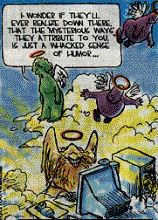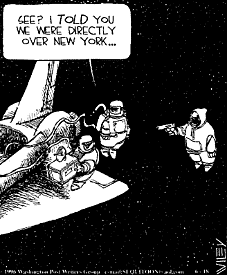The First Electronic
Church of America
Wiley - "Non Sequitur"
You think it strange to see one of FECHA's living heroes coming out of the world of the comics? On a site that features the incomparable St. Howard Hughes, do not be surprised
by anything.
Now we're installing Wiley as one of our living heroes. We are drawn to him because his panel, Non Sequitur, provides a cheery, Sunday morning echo to many of the things that FECHA stands for. Wiley believes in God, the angels and immortality. And so do we.
Take Wiley's current series, featuring Homer, a tubby mesomorph who
spends  his
heavenly time dozing on a cloud, until, every now and then, God decides
he needs "another shot at life on earth." Homer (and Duncan)
are in their third incarnation now (late June), living through what Wiley
calls "The Yukon Experience" -- in 1833. Homer's become a little
button nose kid with an unruly shock of black hair, and Duncan's now a
sled dog, a Husky. How did they end up in the Yukon? Because, in his last
life, Homer had a mean dad. This time, could he have a dad who was cool?
Well, who could be cooler than an Eskimo? That's God's sense of humor,
according to Wiley.
his
heavenly time dozing on a cloud, until, every now and then, God decides
he needs "another shot at life on earth." Homer (and Duncan)
are in their third incarnation now (late June), living through what Wiley
calls "The Yukon Experience" -- in 1833. Homer's become a little
button nose kid with an unruly shock of black hair, and Duncan's now a
sled dog, a Husky. How did they end up in the Yukon? Because, in his last
life, Homer had a mean dad. This time, could he have a dad who was cool?
Well, who could be cooler than an Eskimo? That's God's sense of humor,
according to Wiley.
You might say a wacky sense of humor. In the June 23 strip, we see the face of Wiley's God filled with a maniacal grin as He is (presumably) writing future scenarios for Homer and Duncan -- writing them, naturally enough, on His computer.
We tracked Wiley down -- in Iowa. He turned out to be a prize-winning, hard-working newspaper veteran with a last name just like everyone else. (It's Miller.)
"I like to go in an opposite direction from the herd," Wiley told FECHA. "One of the central precepts in cartooning is that you never kill off a central character. But, with Homer, I can do this on a regular basis. Then bring him back again."
The notion of having a character appear and re-appear on earth in different times and places isn't original. But, as far as we know, no writer has ever presented a hero as observed and applauded by choirs of angels as Homer is. Readers who see Wiley (he's in more than 450 papers) seem to love him. How does Wiley know? Well, they send him e-mail -- no less than 100 messages after each Homer episode from enthusiasts who love what Wiley is saying to them. Or, with what they think Wiley is saying.
"People read a lot into the series," he says self-effacingly. "I'm just a simple story teller." Does the Homer series have no meaning then? Of course it has meaning. "I know what's happening," Wiley says. "People are starved for -- well, I won't call it religion. Maybe it's spirituality. But I get a lot of people telling me how they feel the strip has struck a feeling with them. Ninety-nine percent of the people who write seem to like what they see. In fact, I've only had one critic. He said flatly, 'Heaven isn't like that.' I could only laugh. Nobody -- not even this critic -- knows what heaven is like. This is just my own view."
FECHA members (you're automatically a member if you're reading this)
can see Wiley's
Non Sequitur in both a daily and a Sunday strip. You can also read
two Wiley collections, and order them here
with a double click or ask for them at your local book store. They
are: Dead Lawyers and Other Pleasant Thoughts (Random House 1993) and The
Non Sequitur Survival Guide for the 90s (Andrews & McMeel 1995). Or
click here if you have something to
say to Wiley. SEQUITOON@aol.com.
STILL MORE WILEY STUFF:
 Better
known simply as "Wiley", Wiley Miller is the creator of the comic
strip Non Sequitur, which, since it first appeared in 1992, has
become a favorite of millions of week day and Sunday comic readers, and
a favorite of his peers - the National Cartoonists Society selected Non
Sequitur as the Best Comic Strip of 1993 and the Best Syndicated Panel
of 1996. In addition to Non Sequitur he is part of the "team"
that produces Us and Them. Of Non Sequitur, it's been said, "Wiley
is aptly named...lawyers, IRS agents, doctors agree -- he's the cartoonist
they love to hate!"
Better
known simply as "Wiley", Wiley Miller is the creator of the comic
strip Non Sequitur, which, since it first appeared in 1992, has
become a favorite of millions of week day and Sunday comic readers, and
a favorite of his peers - the National Cartoonists Society selected Non
Sequitur as the Best Comic Strip of 1993 and the Best Syndicated Panel
of 1996. In addition to Non Sequitur he is part of the "team"
that produces Us and Them. Of Non Sequitur, it's been said, "Wiley
is aptly named...lawyers, IRS agents, doctors agree -- he's the cartoonist
they love to hate!"
A recurring part of Non Sequitur is the character Homer who is sent from "Heaven" down to earth, but each time ends up returning, only to be "born again" as yet another mortal. Wiley explained a bit about the concept in a recent on line dialogue on the Newsgroup "news:rec.arts.comics.strips". In responding to someone who apparently wasn't thrilled with the Homer character, Wiley wrote:
"Sorry you don't like the Homer series, but I never was out to please everyone. And, judging from the mail I have been swamped with, I have to tell you that you are in the extreme minority".
Quite frankly, I expected to get more response like yours, but I haven't. I am doing this series for the Sunday's (and it will appear in 3 daily editions later this month) because we have gotten away from story in comics, and each "life" is like getting to create a whole new comic strip.
I like going in the opposite direction as the rest of the herd, and
this format affords me the opportunity to break one the main tenants in
cartooning...I get to kill my central character on a regular basis! I know
this is a departure from my usual material, but that's why I called it
"Non Sequitur".
-Wiley-
To find out more about Wiley, we turn again to Wiley himself,
who wrote this "autobiography":
BORN:
April 15, 1951, in Burbank, California: 10 lbs. 6 oz. - OUCH.
EDUCATION:
High School - McLean, Virginia. My school bus went by Bobby Kennedy's house
every morning. Always wondered what it was like inside.
College- Art major at Virginia Commonwealth University.
CAREER:
1974 - After memorable stints as a sign painter and assistant manager at
a Pizza Hut, began art and cartooning profession in educational film studio
in Los Angeles.
1976 - Staff artist/editorial cartoonist at Greensboro (North Carolina) Daily News.
1978 - Same at Santa Rosa (California) Daily News.
1980 - Editorials began syndication with Copley News Service.
1981 - Recession hit, lost job. Continued syndication and hoped newspapers would begin hiring again.
1982 - No one hiring, so created first comic strip, "Fenton," for North America Syndicate.
1986 - Re-entered editorial cartooning at San Francisco Examiner. Won several awards, last one being the Robert F. Kennedy Journalism Award in 1991. Finally got to go inside Bobby Kennedy's house.
1992 - Another recession, but didn't wait to lose job. Created comic strip "Non Sequitur." It was an immediate success.
1993 - "Non Sequitur" awarded Best Comic Strip at National Cartoonists Society Reuben Awards. Only strip to be honored in its first year of publication.
1994 - Got an idea for a completely new approach to a comic strip that I just couldn't leave alone ... two cartoonists, working autonomously, and alternating every other day with their own cast of characters exploring today's issues from a male's and a female's point of view. Had to find the best professional cartoonist to make it work. That was the easy part: long-time friend and editorial cartoonist for the Ottawa (Canada) Sun, Susan Dewar.
1996 - Won Best Syndicated Panel from National Cartoonists Society - only comic feature to win in 2 different categories.
